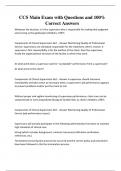CCS Main Exam with Questions and 100%
Correct Answers
Whatever the decision, it is the supervisor who is responsible for making that judgment
and serving as the gatekeeper (Watkins, 1997).
Components of Clinical Supervision Def. - Answer Monitoring Quality of Professional
Service: Supervisors are ultimately responsible for the treatment client's receive. A
supervisor's first responsibility is for the welfare of the client, then the supervisee,
finally the organizational structure of the facility in which they work.
At what point does a supervisor wait for "acceptable" performance from a supervisee?
At what price to the client?
Components of Clinical Supervision Def. - Answer A supervisor should intervene
immediately and take action as necessary when a supervisee's job performance appears
to present problems and/or put the client at risk.
Without proper and vigilant monitoring of supervisee performance, client care can be
compromised or even jeopardized (Knapp & VandeCreek; as cited in Watkins, 1997).
Components of Clinical Supervision Def. - Answer Monitoring Quality of Professional
Service (job performance issues):
Supervisors will actively participate in the following administrative functions to maintain
high standards of clinical care:
Hiring (which includes background, criminal, licensure/certification verification,
references, etc.)
Termination (ensuring due process has occurred and the correct policy and procedures
have been followed in this the termination process.
,Performance recognition (catching people doing something right).
Progressive disciplinary action (according to the policies and procedures of your
organizations and the standards of care).Other personnel decisions
Components of Clinical Supervision Def. - Answer Monitoring Quality of Professional
Service (pharmacological treatment):
Supervisors need to ensure supervisees are trained and knowledgeable in the latest
pharmacological interventions for mental health disorders.
Components of Clinical Supervision Def. - Answer Supervisors need to ensure
supervisees are trained and knowledgeable in the latest pharmacological interventions
for substance use disorders (such as methodone, naltrexone, suboxone, and vivitrol
among others).
Supervisors should be aware of their own biases (if any) surrounding these interventions
and ensure that if a bias exists, it is not passed on to supervisees.
Style in Supervision - Answer Style is the patterns we use in attempting to communicate
with others.
Style consists of the recurring and consistent focus supervisors emphasize in
supervision, the manner in which they state their theoretical orientation, the philosophy
and practice of supervision they hold, and how they convey this to their supervisees.
Common elements of style include voice volume, voice tone, facial expressions, posture,
use of arms and hands, examples given, organization and structure of sessions, physical
setting of sessions, theories used, points chosen to intervene in discussion, how
suggestions are made, and what suggestions are offered.
,Observing One's Style - Answer The best way to observe a supervisor's style of
supervision is through viewing audiovisual recordings of supervisory sessions.
Supervisors should be exposed to the work of other supervisors in order to develop
their styles.
The supervisor needs to develop an orientation or frame of reference to supervision
that incorporates his/her style. This relates to the focus of the supervisory relationship
(i.e., the focus should be that the primary responsibility is to the client). Practitioners
who are having difficulty with their job may attempt to deal with this by attributing the
difficulties to problems they are having with the supervisor. It is the supervisor's
responsibility to keep the focus on the client under discussion.
Main Styles - Answer Active Style of Supervision - the active style consists of being direct
with the supervisee and asking specific questions, answering questions directly, and
offering interpretations. Active supervision is problem focused, based on exploring
alternative interventions, focused on client dynamics, and speculative about outcomes.
Main Styles - Answer Reactive Style of Supervision - This is a more subdued and indirect
style. It involves asking limited general questions and not giving answers. Reactive
supervision focus on the process of treatment, explores issues about interaction, and
tends to focus on the practitioner dynamics, providing a forum for practitioners to
struggle with their own solutions.
Substyles - Answer Philosopher - This is when a supervisor takes the everyday material
from a supervisee and become philosophically abstract with their feedback. For
example, a frustrated supervisee on a case will get the response "It takes 10 years
before a therapist begins to know what he's doing". While making a philosophical point,
supervisee's can become easily frustrated with the lack of clear direction from the
supervisee.
, Theoretician - These supervisors believe the mastery of theory leads to good practice.
Case material will be used as a means to understanding theory.
Substyles - Answer Theoretician - These supervisors believe the mastery of theory leads
to good practice. Case material will be used as a means to understanding theory.
SubStyles - Answer Technician - Technician style is dealing with the details of case
problems and relates them to technical skills. The emphasis here is on what should be
done, and this style is more problem focused and interactionally oriented.
SubStyles - Answer Technical Strategy takes 3 forms-
Planning - planning strategies and techniques that can be used in cases.
Explanation - telling the practitioner what to say to the client.
Description - after the fact exploration of the material.
Here the supervisor's task is to explore interventions and get the supervisee to
differentiate the intent of a given intervention and the actual effect that occurred.
Client and Supervisee Improvement as a result of Supervisory Milieu - Answer Client
improvement, as a measure of the supervisory experience, is related to what and to
what percentage?
The Quality of the Therapeutic Alliance/Working Alliance. (30% of the change).
Extratherapeutic Factors. (40% of the change). These include the counselor's strengths
and capacity for growth, the support systems and the setting the supervisory
relationship takes place.
Client and Supervisee Improvement as a result of Supervisory Milieu - Answer The stage
of readiness for change of the supervisee. Supervisor factors such as a motivating style.
Learning styles, work environment and many other factors.




